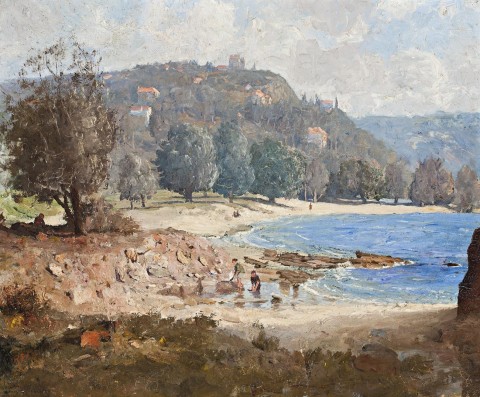SUMMER MORNING, 1927
LLOYD REES
oil on canvas on board
37.0 x 44.0 cm
signed lower left: REES
signed, dated and inscribed with title on artist’s label verso
Dr A. Wallace Weihen, Sydney (label attached to backing board)
Sotheby's, Melbourne, 16 April 1985, lot 18
Christopher Day Gallery, Sydney
Mr and Mrs Rene Rivkin, Sydney
Sotheby’s, Sydney, 3 June 2001, lot 49
Private collection, Canberra
Lloyd Rees Loan Exhibition, National Art Gallery of New South Wales, Sydney, 1 – 30 August 1942, cat. 11 (label attached to backing board, as ‘View in Sydney Harbour’)
Australian Paintings 1824 – 1940, Christopher Day Gallery, Sydney, winter 1985, cat. 61 (illus. in catalogue and on exhibition catalogue cover, as ‘Spit Junction, Middle Harbour, Sydney’)
Free, R., Lloyd Rees, Lansdowne, Melbourne, 1972, cat. O32, p. 110 (as ‘View in Sydney Harbour’)
In the last years of his long life, Lloyd Rees became known as the ‘grand old man’ of Australian art. A passionate and driven artist, his scenes, particularly of Sydney harbour and the hinterland, became touchstones for audiences across the country and inspired artistic colleagues such as the much younger Brett Whiteley. Summer Morning, 1927 is from a small group of paintings made after his tour of England and Italy in 1923 – 24, and marks an early – though sadly brief – period in his life characterised by financial stability and familial happiness following his marriage to Dulcie Metcalfe in August 1926. Moving to Cowles Road, Mosman, ‘a cottage in short walking distance of (Dulcie’s) parents’ home in Muston Street’,1 Rees would travel by tram to explore the nearby coastline and it is highly probable that this painting depicts the rocky northern reaches of Balmoral at the base of Stanton Street. That said, Rees never sought topographical accuracy and would often modify reality to suit his immediate painterly needs.
Rees famously described his first glimpse of Sydney harbour from the porthole of a ship which had brought him from his home town in Brisbane: ‘Opal-blue water, a band of golden sand, another of olive-green trees … It was one of those early calm mornings, when all was veiled under an ethereal mist of blue through which the sun struck on golden foreshores and russet trees, and depicted in creamy light’.2 It is a description which could easily match the painting on offer here. On his return from Europe, Rees had attempted to infuse his paintings with some of the classical atmosphere and solidity he had studied first-hand in the works of the Italian masters. However, recognising its inappropriateness to the local scene, he reinvestigated the art of Arthur Streeton and took from it many cues such as the immediacy and freshness of the artist’s brushstrokes and, in particular, his authentic celebration of the unique Australian light. Like Streeton’s own harbour scenes, there is a remarkable interplay on display in Summer Morning between the ruggedness of the shore, the expanse of sandy beach, the sudden rise of the promontory and self-absorption of bathers exploring the rocks. Such bucolic days were soon to end for the artist however as in October 1927 his wife and newborn son tragically died during childbirth, an event which resulted in a complete nervous breakdown for Rees. Unable to paint standing up, as was his norm, he instead focussed on drawing for the next five years meaning this painting is one of the very few that survive from the period.
The first owner of Summer Morning was the noted Sydney ophthalmic surgeon Dr A. Wallace Weihen of ‘Berwyn’ in Annandale Street, Darling Point, whose daughter Helen was often featured in society pages. Weihen owned works by other significant Australian artists such as Elioth Gruner and following his death in 1946, Rees’ painting stayed with the doctor’s descendants. In 1985, it was purchased by the colourful business identity Rene RivkIn, who in turn dispersed his own significant collection through auction in 2001.
1. Rees, L., Peaks and Valleys: an autobiography, Collins, Sydney, 1985, p. 152
2. Rees, L., Small Treasures of a Lifetime: some early memories of Australian art and artists, Collins, Sydney, 1969, p. 45
ANDREW GAYNOR
